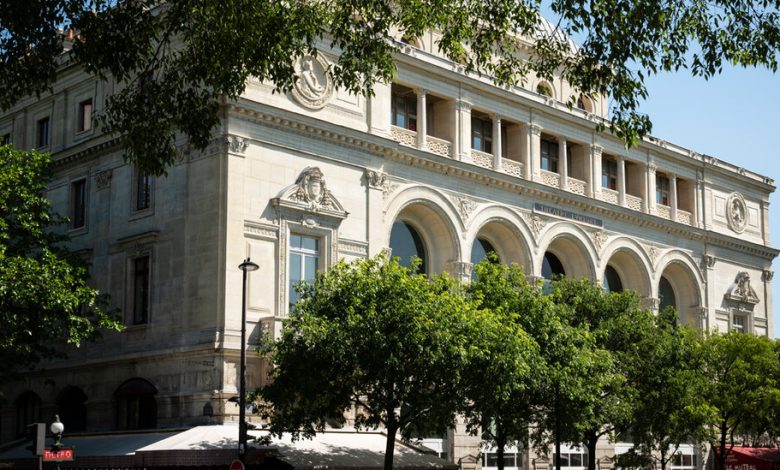After a Long Intermission, a New Act for a Flagship Paris Theater

A lot can happen in seven years. When the Théâtre de la Ville — a flagship venue for Paris’s contemporary dance and theater scene — last welcomed audiences, in late 2016, TikTok had just launched. A pandemic seemed like a far-fetched idea. La(Horde), the influential dance collective featured prominently during the theater’s reopening festivities this month, was still wholly unknown.
Roughly half of the Théâtre de la Ville’s current employees joined during the closure and didn’t set foot in the building during renovations, its director Emmanuel Demarcy-Mota said during a tour of the playhouse last month. (While it was closed, shows continued at a temporary location, the Espace Cardin, at partner venues and on the Théâtre de la Ville’s second stage, Les Abbesses.)
Anticipation for the reopening was high, and the Théâtre de la Ville does look — and feel — different. First, it boasts a new, slightly unwieldy name: the Théâtre de la Ville-Sarah Bernhardt, a nod to its most famous owner, the French actress who ran the space between 1899 and 1923. (The venue’s website has yet to reflect the rebrand.)
The biggest change, however, hits when you walk through the doors. The heavy-looking concrete staircase that led from the entrance into the auditorium has been eliminated. Discrete stairs are now hidden in the back of the hall, and two curved mezzanines in warm wood tones hug the facade — with panoramic views of the neighborhood, including the Théâtre du Châtelet, the rival playhouse that stands across the street.
The closure was never intended to last this long. The initial plan was a partial renovation to bring the Théâtre de la Ville, which hadn’t had a significant upgrade since 1967, up to current security and technical standards. Difficulties quickly piled up, initially because of extensive lead and asbestos, then owing to the Covid pandemic. The total cost, first estimated at 26 million euros, or $27.5 million, ultimately rose to €40 million ($42 million).
The result is a distinctly 21st-century update, which adds yet another layer to what was already an architectural mille-feuille. Inaugurated in 1862, the building was destroyed during the Paris Commune of 1871 and rebuilt a few years later. It was then rebranded several times before the city of Paris chose to reimagine it in 1966. While the facade and roof remained, the Italian-style interior was gutted in favor of a more egalitarian, Brutalist-style auditorium, designed by Jean Perrottet and Valentin Fabre.
The auditorium still feels familiar. While the seats are now a muted shade of sand instead of gray, its concrete underpinnings — dotted here and there with gold leaf — still hang over visitors in the hall. Behind the scenes, however, the stage machinery has been entirely updated. Even the mezzanines are now equipped with curtains and professional lighting, for smaller in situ performances.
And Demarcy-Mota, Théâtre de la Ville’s director since 2008, is attempting to make up for lost time. In early October, the reopening was marked with a free 26-hour performance marathon, “The Great Vigil,” starring around 300 artists from the fields of dance, theater and music.
Some, like the choreographers Angelin Preljocaj and Lucinda Childs, were regulars long before the Théâtre de la Ville closed. Another frequent visitor, the flamenco star Israel Galvan, made a surprise appearance for a brilliant duet with the French harpsichordist Benjamin Alard.
Others were making their Théâtre de la Ville debut, like the pianist Yi-Lin Wu, who set a meditative tone around 1 a.m. with a performance of Ravel’s shimmering “Gaspard de la Nuit.” There was something eerie about wandering the halls late into the night, encountering a highly theatrical statue of Bernhardt playing Phaedra, by a staircase, and climbing up to a newly opened studio, La Coupole, to watch “Ionesco Suite,” a five-play mash-up of the French dramatist’s works, directed by Demarcy-Mota — until well past 3 a.m.
For many visitors at the opening, it was a joyful reunion with a playhouse that shaped much of the French dance scene in the last decades of the 20th century. At that time, the Théâtre de la Ville fiercely promoted avant-garde contemporary dance, and became known as the Parisian home of the Tanztheater luminary Pina Bausch, who visited each year.
This identity had begun to shift in the years before the Théâtre de la Ville closed, with a greater diversity of choreographic trends represented on its stage. Still, during its seven-year absence, other Parisian venues like the Grande Halle of La Villette have stepped up their dance offerings or reoriented their focus to favor more diverse voices and collectives, many of them steeped in street dance styles.
So as the Théâtre de la Ville-Sarah Bernhardt kicked its first season into gear this month, it was sometimes hard to discern what sets it apart from other theaters. High-profile choreographers are no longer identified with individual venues, the way Théâtre de la Ville once was with Bausch: Every programmer in town seems to want the same names.
The collective La(Horde), which took over the stage after “The Great Vigil,” is one example. Less than a week before its run of “Marry Me In Bassiani,” a production the group created for a Georgian company, Iveroni Ensemble, La(Horde) was across the street at the Théâtre du Châtelet with its newest creation, “Age of Content.”
There will be plenty more opportunities to see what Théâtre de la Ville-Sarah Bernhardt does with its revitalized venue as its season progresses. Demarcy-Mota, a theater director who splits his programming between dance, theater and a smattering of music events, said in his inauguration speech last month that he sees the stage as “a space for contradiction.”
And the thrill of discovering new work in a theater known for groundbreaking performances could already be felt last week when La Coupole, the upstairs studio, hosted “En Addicto,” a one-man show inspired by a monthslong residency in a hospital wing devoted to addicts.
Its director and performer, Thomas Quillardet, let the voices of staff and patients alike flow through him with just the right mix of empathy and levity. It brought to mind Demarcy-Mota’s commitment to sending Théâtre de la Ville artists to local hospitals during the pandemic, to share poems or mini-performances. It’s been a long wait, but these artists can finally come home.




